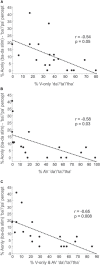Rethinking the Mechanisms Underlying the McGurk Illusion
- PMID: 33867954
- PMCID: PMC8046930
- DOI: 10.3389/fnhum.2021.616049
Rethinking the Mechanisms Underlying the McGurk Illusion
Abstract
The McGurk illusion occurs when listeners hear an illusory percept (i.e., "da"), resulting from mismatched pairings of audiovisual (AV) speech stimuli (i.e., auditory/ba/paired with visual/ga/). Hearing a third percept-distinct from both the auditory and visual input-has been used as evidence of AV fusion. We examined whether the McGurk illusion is instead driven by visual dominance, whereby the third percept, e.g., "da," represents a default percept for visemes with an ambiguous place of articulation (POA), like/ga/. Participants watched videos of a talker uttering various consonant vowels (CVs) with (AV) and without (V-only) audios of/ba/. Individuals transcribed the CV they saw (V-only) or heard (AV). In the V-only condition, individuals predominantly saw "da"/"ta" when viewing CVs with indiscernible POAs. Likewise, in the AV condition, upon perceiving an illusion, they predominantly heard "da"/"ta" for CVs with indiscernible POAs. The illusion was stronger in individuals who exhibited weak/ba/auditory encoding (examined using a control auditory-only task). In Experiment2, we attempted to replicate these findings using stimuli recorded from a different talker. The V-only results were not replicated, but again individuals predominately heard "da"/"ta"/"tha" as an illusory percept for various AV combinations, and the illusion was stronger in individuals who exhibited weak/ba/auditory encoding. These results demonstrate that when visual CVs with indiscernible POAs are paired with a weakly encoded auditory/ba/, listeners default to hearing "da"/"ta"/"tha"-thus, tempering the AV fusion account, and favoring a default mechanism triggered when both AV stimuli are ambiguous.
Keywords: McGurk illusion; audiovisual fusion; cross-modal phonetic encoding; multisensory integration; phonemic representations.
Copyright © 2021 Gonzales, Backer, Mandujano and Shahin.
Conflict of interest statement
The authors declare that the research was conducted in the absence of any commercial or financial relationships that could be construed as a potential conflict of interest.
Figures





Similar articles
-
The McGurk Illusion: A Default Mechanism of the Auditory System.Brain Sci. 2023 Mar 19;13(3):510. doi: 10.3390/brainsci13030510. Brain Sci. 2023. PMID: 36979322 Free PMC article.
-
Neural Mechanisms Underlying Cross-Modal Phonetic Encoding.J Neurosci. 2018 Feb 14;38(7):1835-1849. doi: 10.1523/JNEUROSCI.1566-17.2017. Epub 2017 Dec 20. J Neurosci. 2018. PMID: 29263241 Free PMC article.
-
Cross-modal phonetic encoding facilitates the McGurk illusion and phonemic restoration.J Neurophysiol. 2018 Dec 1;120(6):2988-3000. doi: 10.1152/jn.00262.2018. Epub 2018 Oct 10. J Neurophysiol. 2018. PMID: 30303762 Free PMC article.
-
Neural evidence accounting for interindividual variability of the McGurk illusion.Neurosci Lett. 2019 Aug 10;707:134322. doi: 10.1016/j.neulet.2019.134322. Epub 2019 Jun 7. Neurosci Lett. 2019. PMID: 31181299 Free PMC article.
-
Early and late beta-band power reflect audiovisual perception in the McGurk illusion.J Neurophysiol. 2015 Apr 1;113(7):2342-50. doi: 10.1152/jn.00783.2014. Epub 2015 Jan 7. J Neurophysiol. 2015. PMID: 25568160 Free PMC article.
Cited by
-
Audiovisual speech perception: Moving beyond McGurk.J Acoust Soc Am. 2022 Dec;152(6):3216. doi: 10.1121/10.0015262. J Acoust Soc Am. 2022. PMID: 36586857 Free PMC article.
-
Advances in Understanding the Phenomena and Processing in Audiovisual Speech Perception.Brain Sci. 2023 Sep 20;13(9):1345. doi: 10.3390/brainsci13091345. Brain Sci. 2023. PMID: 37759946 Free PMC article.
-
The McGurk Illusion: A Default Mechanism of the Auditory System.Brain Sci. 2023 Mar 19;13(3):510. doi: 10.3390/brainsci13030510. Brain Sci. 2023. PMID: 36979322 Free PMC article.
-
Perceptual uncertainty explains activation differences between audiovisual congruent speech and McGurk stimuli.Hum Brain Mapp. 2024 Mar;45(4):e26653. doi: 10.1002/hbm.26653. Hum Brain Mapp. 2024. PMID: 38488460 Free PMC article.
References
-
- Andersen T. S., Winther O. (2020). Regularized models ofaudiovisual integration ofspeech with predictive power for sparse behavioral data. J. Math. Psychol. 98:102404. 10.1016/j.jmp.2020.102404 - DOI
Grants and funding
LinkOut - more resources
Full Text Sources
Other Literature Sources

